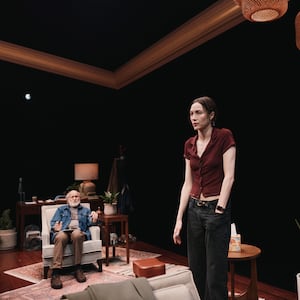Do not disregard the one line of advice which accompanies a booking to Life and Trust (through Sept. 30) in New York City’s Financial District: “It is encouraged that you and your guest join us in comfortable shoes.” Consider yourself emphatically, triple-underlined warned to follow this to the letter.
Whatever you think of Life and Trust—squarely aimed at fans of Sleep No More and produced, like that show, by the immersive theater specialists Emursive–you will end up with legs and buns of steel, given the flights of stairs you ascend and descend in the bowels of the Financial District’s Conwell Tower over a run time of almost 3 hours. Immersive theater like this should really be its own Olympic event.
Just as with Sleep No More, Life and Trust is a multi-roomed, lushly designed fever dream; an evening of hard-on-the-joints choose your own adventure that is sumptuously conceived and lovely to look at, if—for the visitor—exhaustingly executed and ultimately tiresome.
To begin, you sit in the world’s most beautiful holding area—a coffee shop during the non-performance day (where you can work with a laptop, sitting in utter grandeur), and then a bar area for Life and Trust attendees at night. Sup a delicious cocktail on arrival; you are then told by a period-dressed actor that you will soon see the fictional character J.G. Conwell.

Jennifer Florentino and Parker Murphy.
Stephanie CrousillatThe two-and-a-half-hour performance proper begins with you and a small group of others being taken to a dimly lit room to meet the very rich and very fictional J.G. Conwell, a middle-aged rich man confronting a Faustian bargain on the eve of the 1929 Wall Street Crash. He is himself invited, and then invites you, to put on black plastic masks and travel back in time to when he was a young man in the late 19th and early 20th century.
You then are ushered through doors to the full Life and Trust experience. As with Sleep No More: Do not touch the actors, they may try to touch you (if you consent to it), try not to get in anyone’s way, try to avoid being mown down by a character and group of attendees in a rush. Seasoned immersive theater fans will know to look intently for clues—I observed many leaping on any stray scrap of paper and label.
Jon Ronson, who wrote the show, says this was a time of “political and social reform, the birth of cinema and Vaudeville, the explosion of stage magic and escapology, the rise of shadowy underground libertine clubs, Thomas Edison’s lightbulb, and junk sciences like eugenics.” Life And Trust, he writes, “is a Faustian fever dream of Progressive Era New York.”

The stories within the show are true, Ronson says, with every character based on or inspired by a real person who lived in the City in the late 19th or early 20th century.
However, like Sleep No More (yet without the basic knowledge of a well-known text like Macbeth to bolster your comprehension) you would have to come back many times to make narrative sense of Life and Trust. There are 25 stories to follow, multiple characters, and the truly dedicated on the evening I visited seemed to be following a single character like hawks.
These attendees stayed glued to those characters, which looked very odd. However, in retrospect, it might be a good idea. If you do as my friend and I did, and just wander haphazardly from room to room, up and down stairs—the design and conception is so good and so wild, an extravagant and painstakingly realized visual feast—you happen on a series of surreal incidents which really don’t make much sense.
There are no words spoken and a lot of dazzling, sleek movement, and fabulously designed spaces by Gabriel Hainer Evansohn, and just as stunning costumes (Emilio Sosa), lighting (Jeanette Yew), music (Taylor Bense, Owen Belton), and sound (Brendan Aanes, Michael Kiley, Nick Kourtides). All combine to the clanging, haunted-house atmosphere of sexual licentiousness and seamy, wordless plotting and shenanigans.

Parker Murphy and Kevin M Pajarillaga.
Jane KratochvilSometimes characters enter other characters’ scenes, and there can be amorous passion, drunken ribaldry, a fight, or stricken looks of hatred and smoldering glances—all choreographed and directed with precision by Teddy Bergman, with co-direction by Jeff Kuperman and Rick Kuperman.
There are, we are told, Faustian elements to each narrative, about “what we are willing to trade our souls for and thereby what we value most highly,” Bergman says. Well, maybe—we just saw a bunch of people behaving kind of naughtily and having mute but intense outbursts.
My friend and I watched women getting passionate with each other, the production and sale of a drug that the lead character owned, other hetero hidden passions be exposed, maids, random characters shoot panicked looks at each other, a beautiful, shorn-headed person on some kind of emotionally overwrought quest and having a meltdown, money being destroyed, muffled cackling, a hot, muscled shirtless character stalking through the corridors, and—possibly in my favorite, simplest-designed space—a dancer doing a routine in a miniature theater. Characters ran down corridors in states of questionable distress, or walked with calm assurance as masked attendees followed their every step.
Story themes that flickered in an out of sight seemed to be about money, capitalism, power, art, identity, inner torment, and secret passions. Further notes I was later given reveal specific characters’ stories, which you would need to follow individually to make any sense at all. Nothing I read about the characters afterwards played out coherently in front of me. If you take a pick-and-mix approach to Life and Trust, you’ll get, like any Lucky Dip, a little bit of everything, but not a whole lot of something.
There are swish bedrooms, flesh-displaying burlesque, antique-everything, an amazing boulevard of fake grass, a speakeasy where a handsome man flung himself around tables, and then in a booth stroked my hand softly, before darting up on to a wall. And then… well someone else came through the door and my attention flickered to them.
Just as with Sleep No More, whoever you’ve been following in whatever state of bafflement, understanding, clue-hunting, impatience, and physical exhaustion you are in, leads to one place; here, events end in a huge main hall where, as in Sleep No More, visitors are given one last visual blast—this one propulsively physical and theatrical.
It was good to see all the performers who we had shared scattered moments with—and who have been working so hard and intently in the labyrinthine rooms and corridors in the belly of the building—all together for a grand finale.
They all deserve to be mentioned in total (especially as they are also credited as devisers and co-choreographers): Bria Bacon, Tony Bordonaro, Sophie Bortolussi, Nathaniel Buchsbaum, Marc J Cardarelli, Aaron Dalla Villa, Tiffany Violet De Alba, Charles-Alexis Desgagnés, Mia DiLena, Brendan Duggan, Zachary Eisenstat, Raymond Ejiofor, Kim Fischer, Jennifer Florentino, Reshma Gajjar, Douglas J Gillespie, Annie Grove, Alonso Guzman, Dorchel Haqq, Casey Bronwyn Howes, Karl Kenzler, Heather Lang, Majella Bess Loughran, Jodi McFadden, Nando Morland, Parker Murphy, Kevin M Pajarillaga, Marla Phelan, Randolph Curtis Rand, Luca Renzi, Gabriella Sibeko, Tori Sparks, Brandin Steffensen, Derek Tabada, Tony Torn, Mike Tyus, Robert Vail, Ryan VanCompernolle, Jacob Michael Warren, Maleek M Washington, and Madeline Wright.
For this (I think!) one-time only participant, Life and Trust was always beautiful to look at, and occasionally captivating as an experience, but without a cohering story to unfurl and something narratively to mold in my mind, it was also frustrating, tiring, and—after hours of wandering around, despite all the striking visual stimuli—thoroughly, teeth-grindingly irritating. This a fun and beautifully, impressively rendered playground, but you will need a lot of time, money, and sensible shoes to make proper sense of it. Its own Faustian bargain, you might say.







